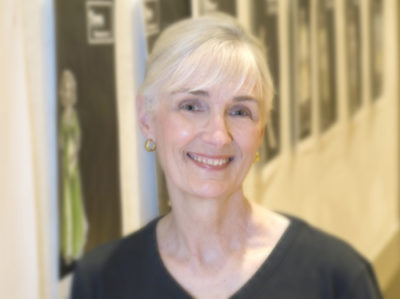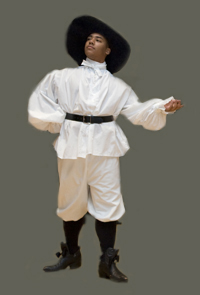Movement experts now have a new tool
After years of classroom instruction and choreography for theatre companies in Kansas City and worldwide, Jennifer Martin found the digital age beckoning. And in typical professional fashion, Martin, Hall Family Foundation Professor of Theatre, quickly rose to the occasion.
The Association of Theatre Movement Educators’ ATME Journal documents the original work of theatre movement specialists. Martin is a founding board member and contributor to the new online publication.
Part magazine, part training film
The ATME Journal is billed as a digital kinetic journal. But as Martin explains, it is so much more.
“The non-profit, peer-reviewed journal is a prototype of what useful kinetic sites should be,” she said. “Articles must meet strict criteria of original, scholarly research and visuals that convey the essence of movement.”
“A question should be answered or a problem solved,” said Martin.
Preparing an article for the journal involves costuming, filming, editing and permission for music use – all fees paid by the author. Articles are kept to between 10 and 15 minutes in length, and must be purposeful – helping actors process and interpret the motions that make a role convincing. The filmed action demonstrates original ideas appropriate to the historical era or the context of the piece: entering a room, bowing, flirting with a fan or a wink. Other supplementary information may be added, such as interviews, drawings or photographs or a voice-over explaining the action.
“And,” added Martin, “articles should be equally accessible to a street performer, a mime or a stroke victim.”
Convincing movement specialists to participate has taken some effort.
“This visual form of question and answer is hard for them to conceptualize,” Martin said.
“But we owe it to our membership,” she continued. “We have an obligation to present them with the best and freshest research and scholarship. Movement experts have a lot to offer their colleagues, and a kinetic journal is a logical tool.”
In the classroom
The journal’s editorial board greatly appreciates Martin’s article because of her high standard of scholarship and practical demonstration. Furthermore, they believe it will guide other submissions toward the same high standards.
“I have used the approach Jennifer has developed with great success in my own production coaching,” said Sarah Barker, ATME editor.
Movement – like other elements of drama and theatre – is a specialty that may be a hidden ingredient to the success or failure of a performance. The Internet is a medium that is appropriate to moving content, and Martin believes the ATME Journal may serve as a Cliff’s Notes for getting started with online presentation of new concepts of movement. Also, such an article can help a faculty member present research for tenure or secure grants.
“A kinetic article is a very effective training tool to show actors the whole process of using a period movement score before they actually begin to learn the technique,” Martin said.
Because material can be downloaded from the Journal site, most movement specialists go there and make their own DVDs – a printout of sorts. Likewise, Martin makes copies for her students.
“Movement specialists around the country also have used it to teach the period movement score in their classes and for rehearsals. When I’ve been invited to teach at other universities or do theatre training, I emphasize the value and convenience of this kind of article.”
Ways the journal may be used
The long-term goal is to become a mainstream source – the go-to place for people who work with the body. Movement specialists may be multifaceted, applying their knowledge to many subjects for different outcomes. Knowledge of movement is at the root of many disciplines other than live theatre.
Therapists and gerontologists need to know the art or science of movement, as do martial arts instructors, models, wellness specialists and conditioning coaches. Corporate customers may use movement specialists or kinetic journal pieces to educate employees about body language and the meaning implicit in certain moves and gestures.
Articles can be converted to DVDs, streamed into classrooms or used for training at regional or national conferences. Colleagues can mentor one another, offering feedback, ideas and advice to on-line journalists. Martin believes that, with the lively launch given to the ATME Journal, other movement specialists will begin to explore the infinite possibilities.


